Graduate Certificate in Nursing: Case Analysis of Mr. Orkins' Stroke
VerifiedAdded on 2022/10/01
|10
|2312
|86
Case Study
AI Summary
This case analysis focuses on Mr. Orkins, an 84-year-old patient admitted after a fall and presenting with stroke symptoms. The analysis details the patient's medical history, including diabetes, hypertension, and hyperlipidemia, and the initial assessments. It covers primary, secondary, and focused assessments, including vital signs, neurological evaluations (GCS), and medication review. The analysis highlights potential adverse effects of the patient's medications and the need for cultural sensitivity, given the patient's Aboriginal background. Nursing interventions discussed include continuous monitoring, oxygen administration, and blood pressure control, emphasizing the importance of timely intervention and culturally appropriate care. The case concludes with recommendations for improved organizational strategies and a call for a male nurse to be assigned to the patient, reflecting cultural considerations.
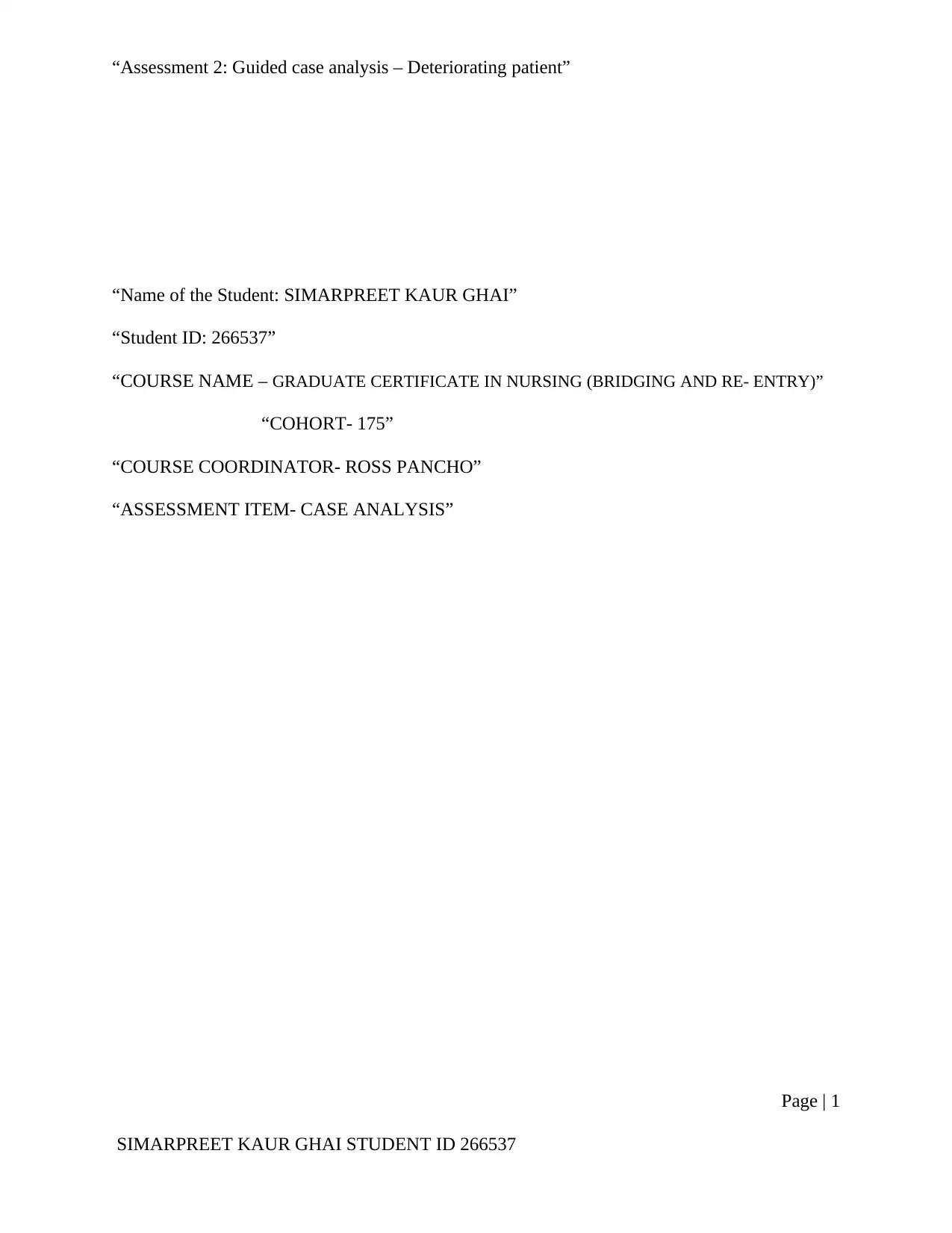
“Assessment 2: Guided case analysis – Deteriorating patient”
“Name of the Student: SIMARPREET KAUR GHAI”
“Student ID: 266537”
“COURSE NAME – GRADUATE CERTIFICATE IN NURSING (BRIDGING AND RE- ENTRY)”
“COHORT- 175”
“COURSE COORDINATOR- ROSS PANCHO”
“ASSESSMENT ITEM- CASE ANALYSIS”
Page | 1
SIMARPREET KAUR GHAI STUDENT ID 266537
“Name of the Student: SIMARPREET KAUR GHAI”
“Student ID: 266537”
“COURSE NAME – GRADUATE CERTIFICATE IN NURSING (BRIDGING AND RE- ENTRY)”
“COHORT- 175”
“COURSE COORDINATOR- ROSS PANCHO”
“ASSESSMENT ITEM- CASE ANALYSIS”
Page | 1
SIMARPREET KAUR GHAI STUDENT ID 266537
Paraphrase This Document
Need a fresh take? Get an instant paraphrase of this document with our AI Paraphraser
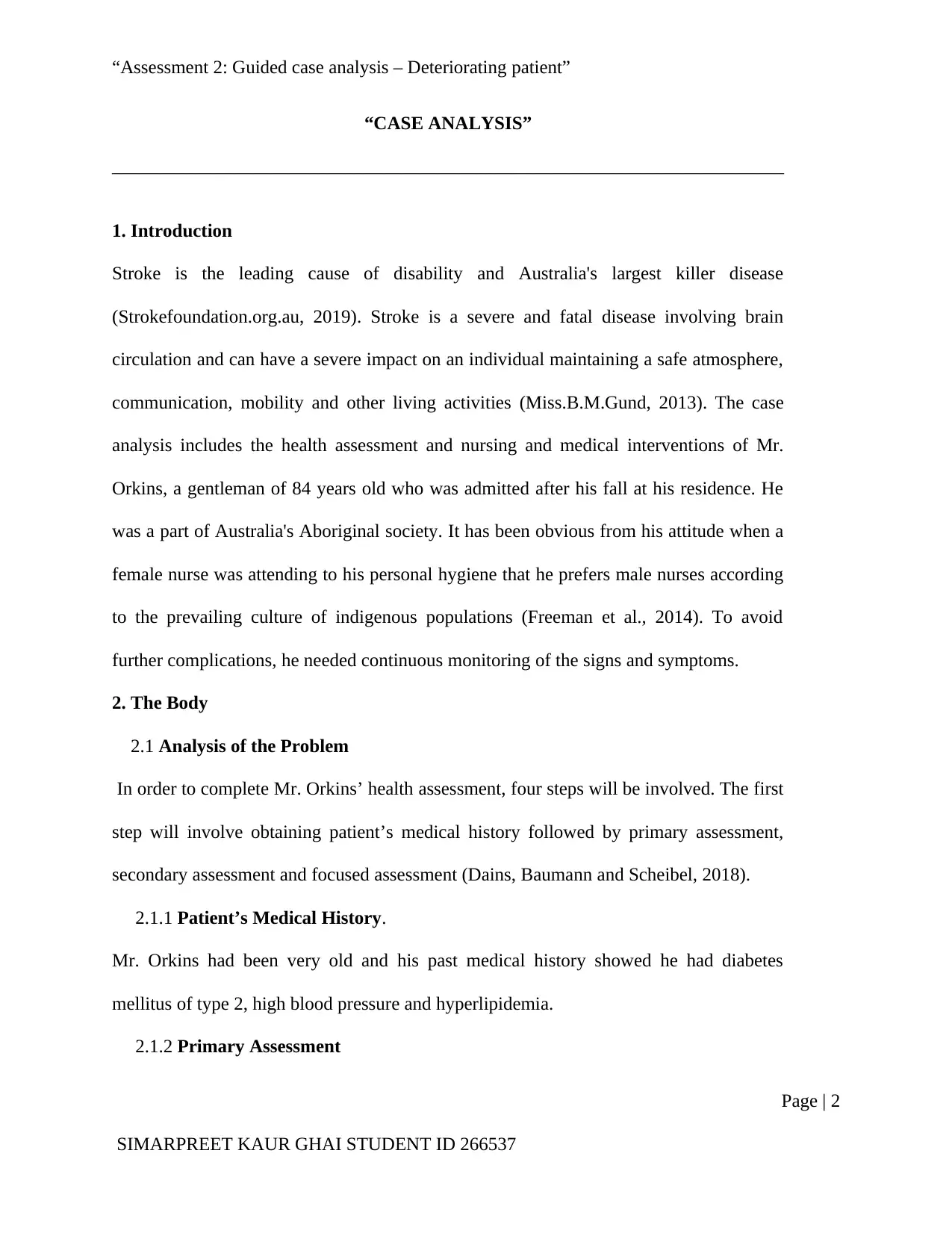
“Assessment 2: Guided case analysis – Deteriorating patient”
“CASE ANALYSIS”
________________________________________________________________________
1. Introduction
Stroke is the leading cause of disability and Australia's largest killer disease
(Strokefoundation.org.au, 2019). Stroke is a severe and fatal disease involving brain
circulation and can have a severe impact on an individual maintaining a safe atmosphere,
communication, mobility and other living activities (Miss.B.M.Gund, 2013). The case
analysis includes the health assessment and nursing and medical interventions of Mr.
Orkins, a gentleman of 84 years old who was admitted after his fall at his residence. He
was a part of Australia's Aboriginal society. It has been obvious from his attitude when a
female nurse was attending to his personal hygiene that he prefers male nurses according
to the prevailing culture of indigenous populations (Freeman et al., 2014). To avoid
further complications, he needed continuous monitoring of the signs and symptoms.
2. The Body
2.1 Analysis of the Problem
In order to complete Mr. Orkins’ health assessment, four steps will be involved. The first
step will involve obtaining patient’s medical history followed by primary assessment,
secondary assessment and focused assessment (Dains, Baumann and Scheibel, 2018).
2.1.1 Patient’s Medical History.
Mr. Orkins had been very old and his past medical history showed he had diabetes
mellitus of type 2, high blood pressure and hyperlipidemia.
2.1.2 Primary Assessment
Page | 2
SIMARPREET KAUR GHAI STUDENT ID 266537
“CASE ANALYSIS”
________________________________________________________________________
1. Introduction
Stroke is the leading cause of disability and Australia's largest killer disease
(Strokefoundation.org.au, 2019). Stroke is a severe and fatal disease involving brain
circulation and can have a severe impact on an individual maintaining a safe atmosphere,
communication, mobility and other living activities (Miss.B.M.Gund, 2013). The case
analysis includes the health assessment and nursing and medical interventions of Mr.
Orkins, a gentleman of 84 years old who was admitted after his fall at his residence. He
was a part of Australia's Aboriginal society. It has been obvious from his attitude when a
female nurse was attending to his personal hygiene that he prefers male nurses according
to the prevailing culture of indigenous populations (Freeman et al., 2014). To avoid
further complications, he needed continuous monitoring of the signs and symptoms.
2. The Body
2.1 Analysis of the Problem
In order to complete Mr. Orkins’ health assessment, four steps will be involved. The first
step will involve obtaining patient’s medical history followed by primary assessment,
secondary assessment and focused assessment (Dains, Baumann and Scheibel, 2018).
2.1.1 Patient’s Medical History.
Mr. Orkins had been very old and his past medical history showed he had diabetes
mellitus of type 2, high blood pressure and hyperlipidemia.
2.1.2 Primary Assessment
Page | 2
SIMARPREET KAUR GHAI STUDENT ID 266537
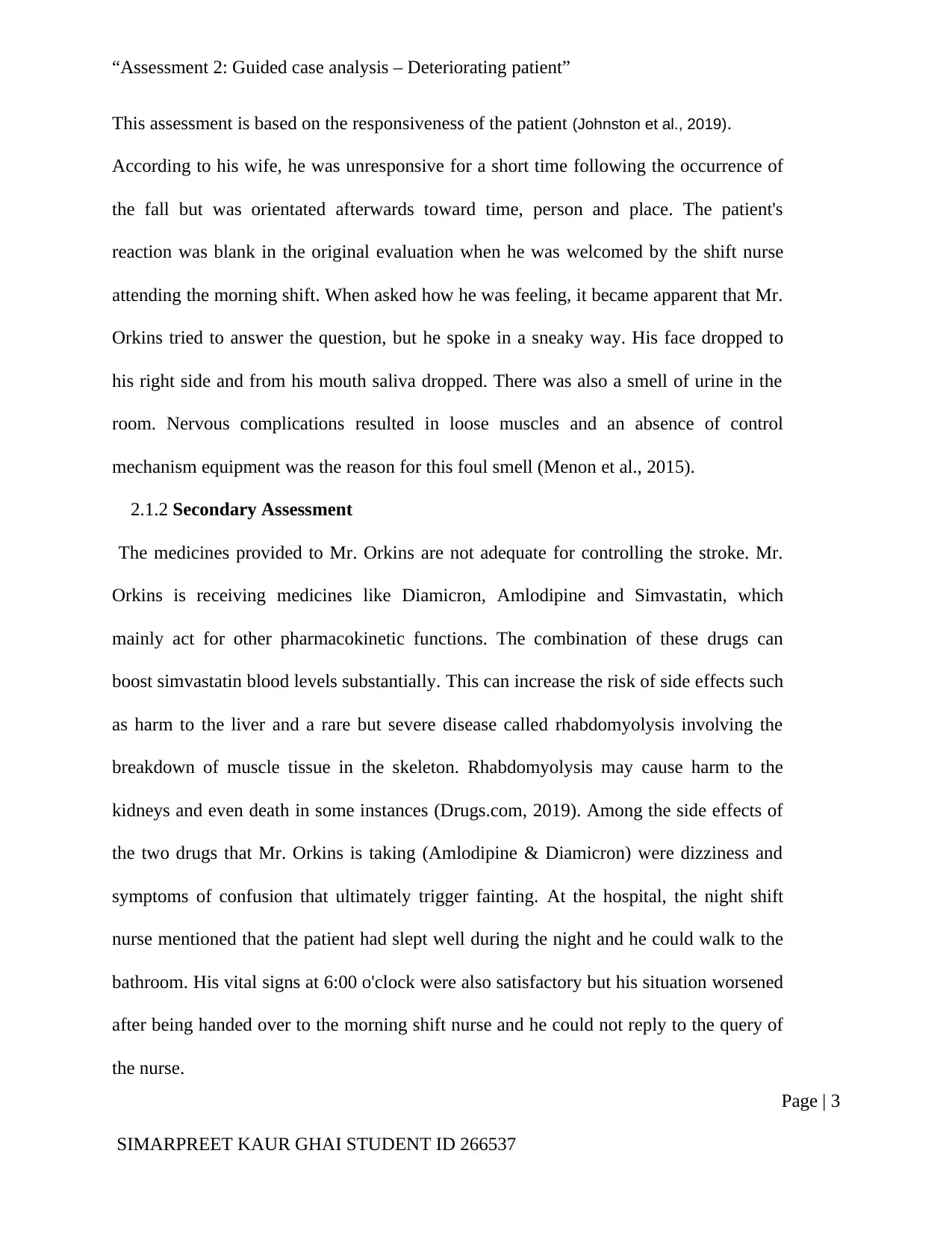
“Assessment 2: Guided case analysis – Deteriorating patient”
This assessment is based on the responsiveness of the patient (Johnston et al., 2019).
According to his wife, he was unresponsive for a short time following the occurrence of
the fall but was orientated afterwards toward time, person and place. The patient's
reaction was blank in the original evaluation when he was welcomed by the shift nurse
attending the morning shift. When asked how he was feeling, it became apparent that Mr.
Orkins tried to answer the question, but he spoke in a sneaky way. His face dropped to
his right side and from his mouth saliva dropped. There was also a smell of urine in the
room. Nervous complications resulted in loose muscles and an absence of control
mechanism equipment was the reason for this foul smell (Menon et al., 2015).
2.1.2 Secondary Assessment
The medicines provided to Mr. Orkins are not adequate for controlling the stroke. Mr.
Orkins is receiving medicines like Diamicron, Amlodipine and Simvastatin, which
mainly act for other pharmacokinetic functions. The combination of these drugs can
boost simvastatin blood levels substantially. This can increase the risk of side effects such
as harm to the liver and a rare but severe disease called rhabdomyolysis involving the
breakdown of muscle tissue in the skeleton. Rhabdomyolysis may cause harm to the
kidneys and even death in some instances (Drugs.com, 2019). Among the side effects of
the two drugs that Mr. Orkins is taking (Amlodipine & Diamicron) were dizziness and
symptoms of confusion that ultimately trigger fainting. At the hospital, the night shift
nurse mentioned that the patient had slept well during the night and he could walk to the
bathroom. His vital signs at 6:00 o'clock were also satisfactory but his situation worsened
after being handed over to the morning shift nurse and he could not reply to the query of
the nurse.
Page | 3
SIMARPREET KAUR GHAI STUDENT ID 266537
This assessment is based on the responsiveness of the patient (Johnston et al., 2019).
According to his wife, he was unresponsive for a short time following the occurrence of
the fall but was orientated afterwards toward time, person and place. The patient's
reaction was blank in the original evaluation when he was welcomed by the shift nurse
attending the morning shift. When asked how he was feeling, it became apparent that Mr.
Orkins tried to answer the question, but he spoke in a sneaky way. His face dropped to
his right side and from his mouth saliva dropped. There was also a smell of urine in the
room. Nervous complications resulted in loose muscles and an absence of control
mechanism equipment was the reason for this foul smell (Menon et al., 2015).
2.1.2 Secondary Assessment
The medicines provided to Mr. Orkins are not adequate for controlling the stroke. Mr.
Orkins is receiving medicines like Diamicron, Amlodipine and Simvastatin, which
mainly act for other pharmacokinetic functions. The combination of these drugs can
boost simvastatin blood levels substantially. This can increase the risk of side effects such
as harm to the liver and a rare but severe disease called rhabdomyolysis involving the
breakdown of muscle tissue in the skeleton. Rhabdomyolysis may cause harm to the
kidneys and even death in some instances (Drugs.com, 2019). Among the side effects of
the two drugs that Mr. Orkins is taking (Amlodipine & Diamicron) were dizziness and
symptoms of confusion that ultimately trigger fainting. At the hospital, the night shift
nurse mentioned that the patient had slept well during the night and he could walk to the
bathroom. His vital signs at 6:00 o'clock were also satisfactory but his situation worsened
after being handed over to the morning shift nurse and he could not reply to the query of
the nurse.
Page | 3
SIMARPREET KAUR GHAI STUDENT ID 266537
⊘ This is a preview!⊘
Do you want full access?
Subscribe today to unlock all pages.

Trusted by 1+ million students worldwide
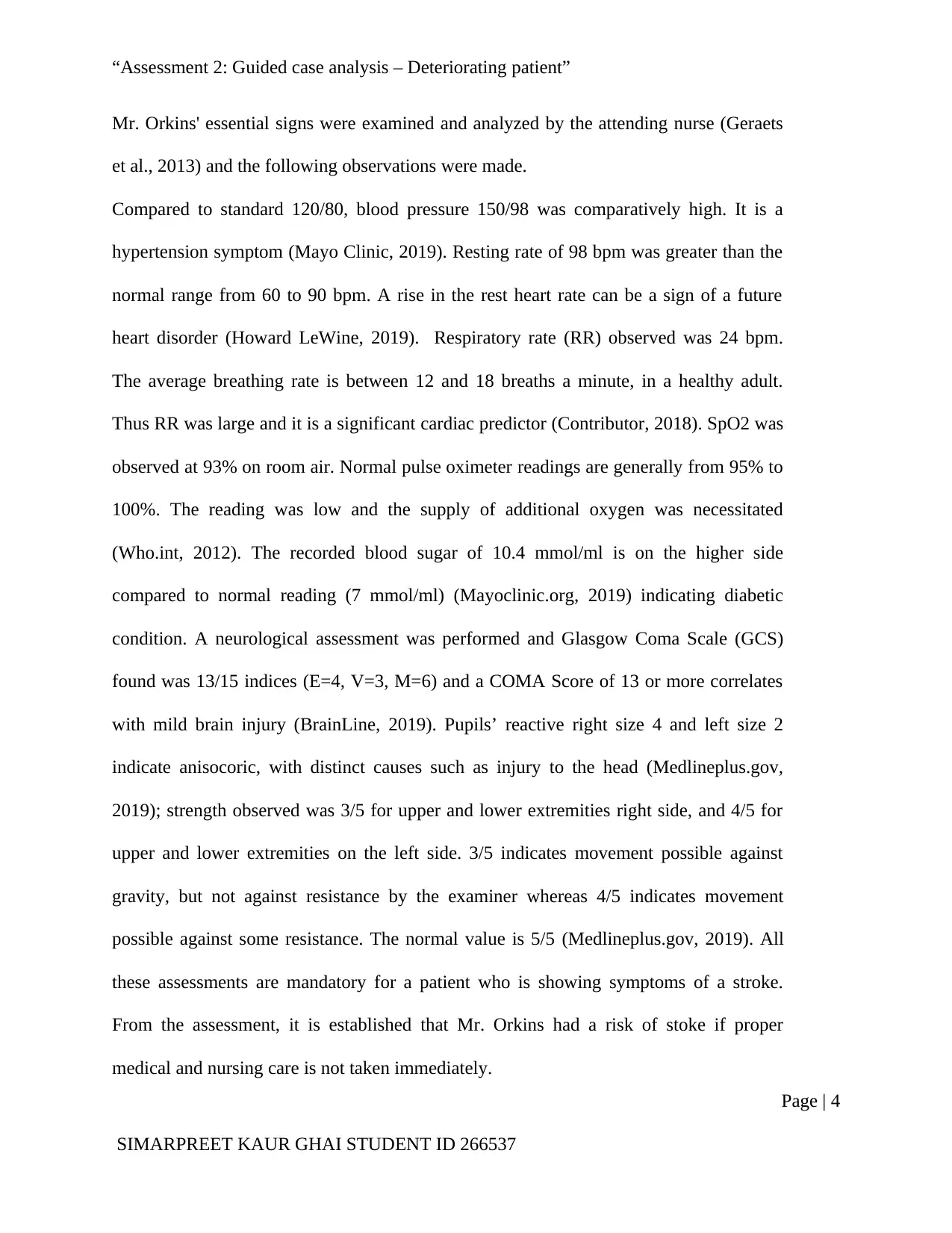
“Assessment 2: Guided case analysis – Deteriorating patient”
Mr. Orkins' essential signs were examined and analyzed by the attending nurse (Geraets
et al., 2013) and the following observations were made.
Compared to standard 120/80, blood pressure 150/98 was comparatively high. It is a
hypertension symptom (Mayo Clinic, 2019). Resting rate of 98 bpm was greater than the
normal range from 60 to 90 bpm. A rise in the rest heart rate can be a sign of a future
heart disorder (Howard LeWine, 2019). Respiratory rate (RR) observed was 24 bpm.
The average breathing rate is between 12 and 18 breaths a minute, in a healthy adult.
Thus RR was large and it is a significant cardiac predictor (Contributor, 2018). SpO2 was
observed at 93% on room air. Normal pulse oximeter readings are generally from 95% to
100%. The reading was low and the supply of additional oxygen was necessitated
(Who.int, 2012). The recorded blood sugar of 10.4 mmol/ml is on the higher side
compared to normal reading (7 mmol/ml) (Mayoclinic.org, 2019) indicating diabetic
condition. A neurological assessment was performed and Glasgow Coma Scale (GCS)
found was 13/15 indices (E=4, V=3, M=6) and a COMA Score of 13 or more correlates
with mild brain injury (BrainLine, 2019). Pupils’ reactive right size 4 and left size 2
indicate anisocoric, with distinct causes such as injury to the head (Medlineplus.gov,
2019); strength observed was 3/5 for upper and lower extremities right side, and 4/5 for
upper and lower extremities on the left side. 3/5 indicates movement possible against
gravity, but not against resistance by the examiner whereas 4/5 indicates movement
possible against some resistance. The normal value is 5/5 (Medlineplus.gov, 2019). All
these assessments are mandatory for a patient who is showing symptoms of a stroke.
From the assessment, it is established that Mr. Orkins had a risk of stoke if proper
medical and nursing care is not taken immediately.
Page | 4
SIMARPREET KAUR GHAI STUDENT ID 266537
Mr. Orkins' essential signs were examined and analyzed by the attending nurse (Geraets
et al., 2013) and the following observations were made.
Compared to standard 120/80, blood pressure 150/98 was comparatively high. It is a
hypertension symptom (Mayo Clinic, 2019). Resting rate of 98 bpm was greater than the
normal range from 60 to 90 bpm. A rise in the rest heart rate can be a sign of a future
heart disorder (Howard LeWine, 2019). Respiratory rate (RR) observed was 24 bpm.
The average breathing rate is between 12 and 18 breaths a minute, in a healthy adult.
Thus RR was large and it is a significant cardiac predictor (Contributor, 2018). SpO2 was
observed at 93% on room air. Normal pulse oximeter readings are generally from 95% to
100%. The reading was low and the supply of additional oxygen was necessitated
(Who.int, 2012). The recorded blood sugar of 10.4 mmol/ml is on the higher side
compared to normal reading (7 mmol/ml) (Mayoclinic.org, 2019) indicating diabetic
condition. A neurological assessment was performed and Glasgow Coma Scale (GCS)
found was 13/15 indices (E=4, V=3, M=6) and a COMA Score of 13 or more correlates
with mild brain injury (BrainLine, 2019). Pupils’ reactive right size 4 and left size 2
indicate anisocoric, with distinct causes such as injury to the head (Medlineplus.gov,
2019); strength observed was 3/5 for upper and lower extremities right side, and 4/5 for
upper and lower extremities on the left side. 3/5 indicates movement possible against
gravity, but not against resistance by the examiner whereas 4/5 indicates movement
possible against some resistance. The normal value is 5/5 (Medlineplus.gov, 2019). All
these assessments are mandatory for a patient who is showing symptoms of a stroke.
From the assessment, it is established that Mr. Orkins had a risk of stoke if proper
medical and nursing care is not taken immediately.
Page | 4
SIMARPREET KAUR GHAI STUDENT ID 266537
Paraphrase This Document
Need a fresh take? Get an instant paraphrase of this document with our AI Paraphraser
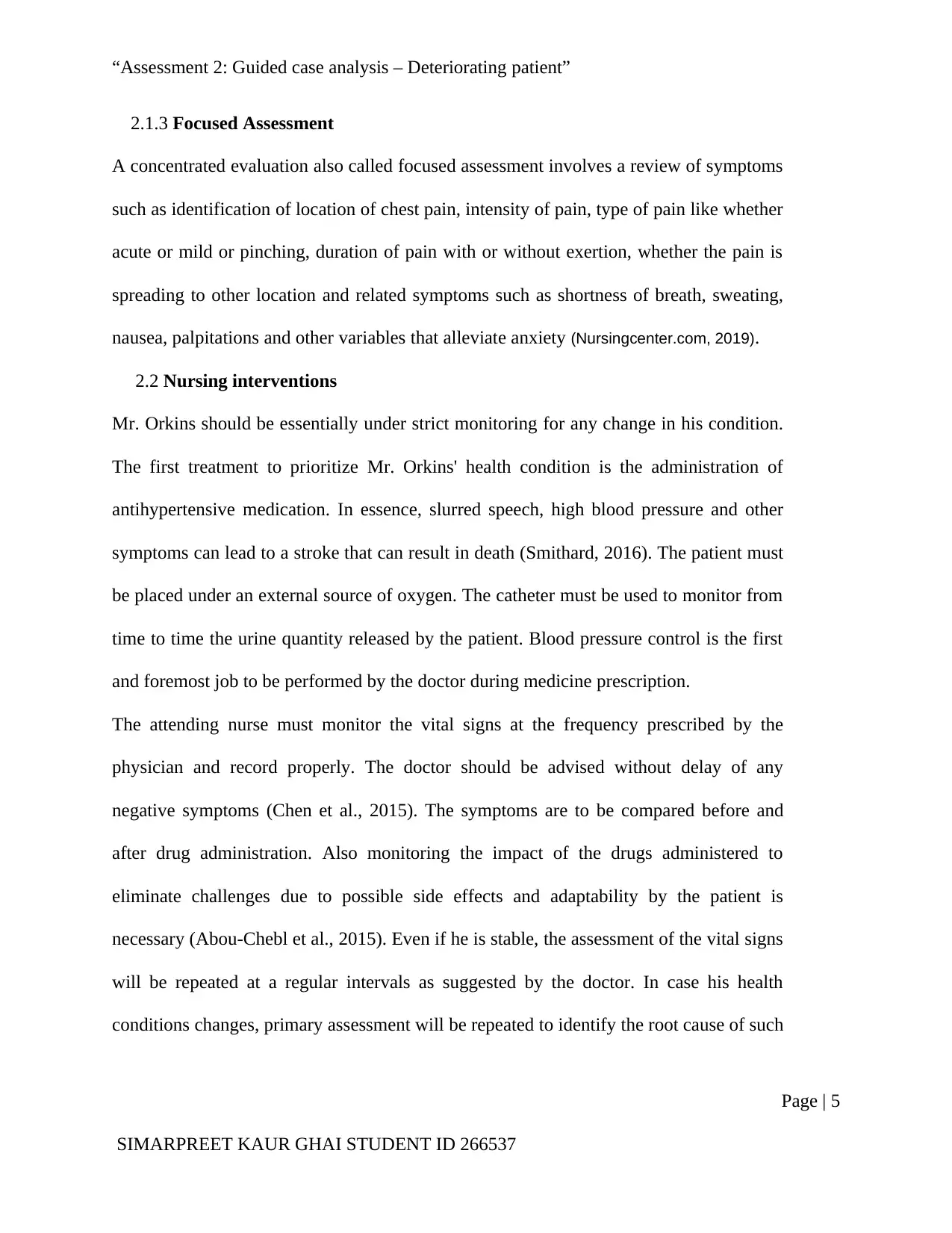
“Assessment 2: Guided case analysis – Deteriorating patient”
2.1.3 Focused Assessment
A concentrated evaluation also called focused assessment involves a review of symptoms
such as identification of location of chest pain, intensity of pain, type of pain like whether
acute or mild or pinching, duration of pain with or without exertion, whether the pain is
spreading to other location and related symptoms such as shortness of breath, sweating,
nausea, palpitations and other variables that alleviate anxiety (Nursingcenter.com, 2019).
2.2 Nursing interventions
Mr. Orkins should be essentially under strict monitoring for any change in his condition.
The first treatment to prioritize Mr. Orkins' health condition is the administration of
antihypertensive medication. In essence, slurred speech, high blood pressure and other
symptoms can lead to a stroke that can result in death (Smithard, 2016). The patient must
be placed under an external source of oxygen. The catheter must be used to monitor from
time to time the urine quantity released by the patient. Blood pressure control is the first
and foremost job to be performed by the doctor during medicine prescription.
The attending nurse must monitor the vital signs at the frequency prescribed by the
physician and record properly. The doctor should be advised without delay of any
negative symptoms (Chen et al., 2015). The symptoms are to be compared before and
after drug administration. Also monitoring the impact of the drugs administered to
eliminate challenges due to possible side effects and adaptability by the patient is
necessary (Abou-Chebl et al., 2015). Even if he is stable, the assessment of the vital signs
will be repeated at a regular intervals as suggested by the doctor. In case his health
conditions changes, primary assessment will be repeated to identify the root cause of such
Page | 5
SIMARPREET KAUR GHAI STUDENT ID 266537
2.1.3 Focused Assessment
A concentrated evaluation also called focused assessment involves a review of symptoms
such as identification of location of chest pain, intensity of pain, type of pain like whether
acute or mild or pinching, duration of pain with or without exertion, whether the pain is
spreading to other location and related symptoms such as shortness of breath, sweating,
nausea, palpitations and other variables that alleviate anxiety (Nursingcenter.com, 2019).
2.2 Nursing interventions
Mr. Orkins should be essentially under strict monitoring for any change in his condition.
The first treatment to prioritize Mr. Orkins' health condition is the administration of
antihypertensive medication. In essence, slurred speech, high blood pressure and other
symptoms can lead to a stroke that can result in death (Smithard, 2016). The patient must
be placed under an external source of oxygen. The catheter must be used to monitor from
time to time the urine quantity released by the patient. Blood pressure control is the first
and foremost job to be performed by the doctor during medicine prescription.
The attending nurse must monitor the vital signs at the frequency prescribed by the
physician and record properly. The doctor should be advised without delay of any
negative symptoms (Chen et al., 2015). The symptoms are to be compared before and
after drug administration. Also monitoring the impact of the drugs administered to
eliminate challenges due to possible side effects and adaptability by the patient is
necessary (Abou-Chebl et al., 2015). Even if he is stable, the assessment of the vital signs
will be repeated at a regular intervals as suggested by the doctor. In case his health
conditions changes, primary assessment will be repeated to identify the root cause of such
Page | 5
SIMARPREET KAUR GHAI STUDENT ID 266537
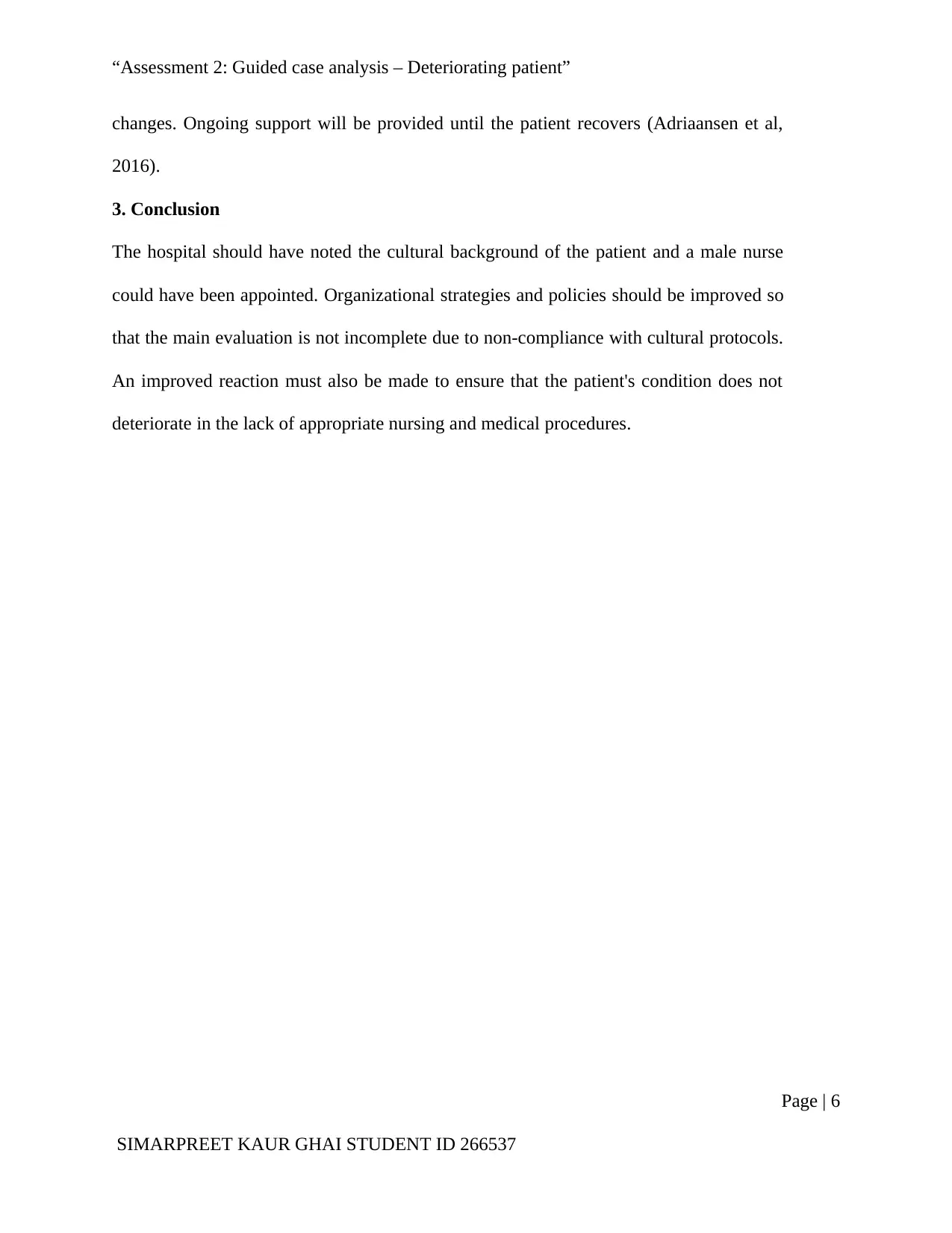
“Assessment 2: Guided case analysis – Deteriorating patient”
changes. Ongoing support will be provided until the patient recovers (Adriaansen et al,
2016).
3. Conclusion
The hospital should have noted the cultural background of the patient and a male nurse
could have been appointed. Organizational strategies and policies should be improved so
that the main evaluation is not incomplete due to non-compliance with cultural protocols.
An improved reaction must also be made to ensure that the patient's condition does not
deteriorate in the lack of appropriate nursing and medical procedures.
Page | 6
SIMARPREET KAUR GHAI STUDENT ID 266537
changes. Ongoing support will be provided until the patient recovers (Adriaansen et al,
2016).
3. Conclusion
The hospital should have noted the cultural background of the patient and a male nurse
could have been appointed. Organizational strategies and policies should be improved so
that the main evaluation is not incomplete due to non-compliance with cultural protocols.
An improved reaction must also be made to ensure that the patient's condition does not
deteriorate in the lack of appropriate nursing and medical procedures.
Page | 6
SIMARPREET KAUR GHAI STUDENT ID 266537
⊘ This is a preview!⊘
Do you want full access?
Subscribe today to unlock all pages.

Trusted by 1+ million students worldwide
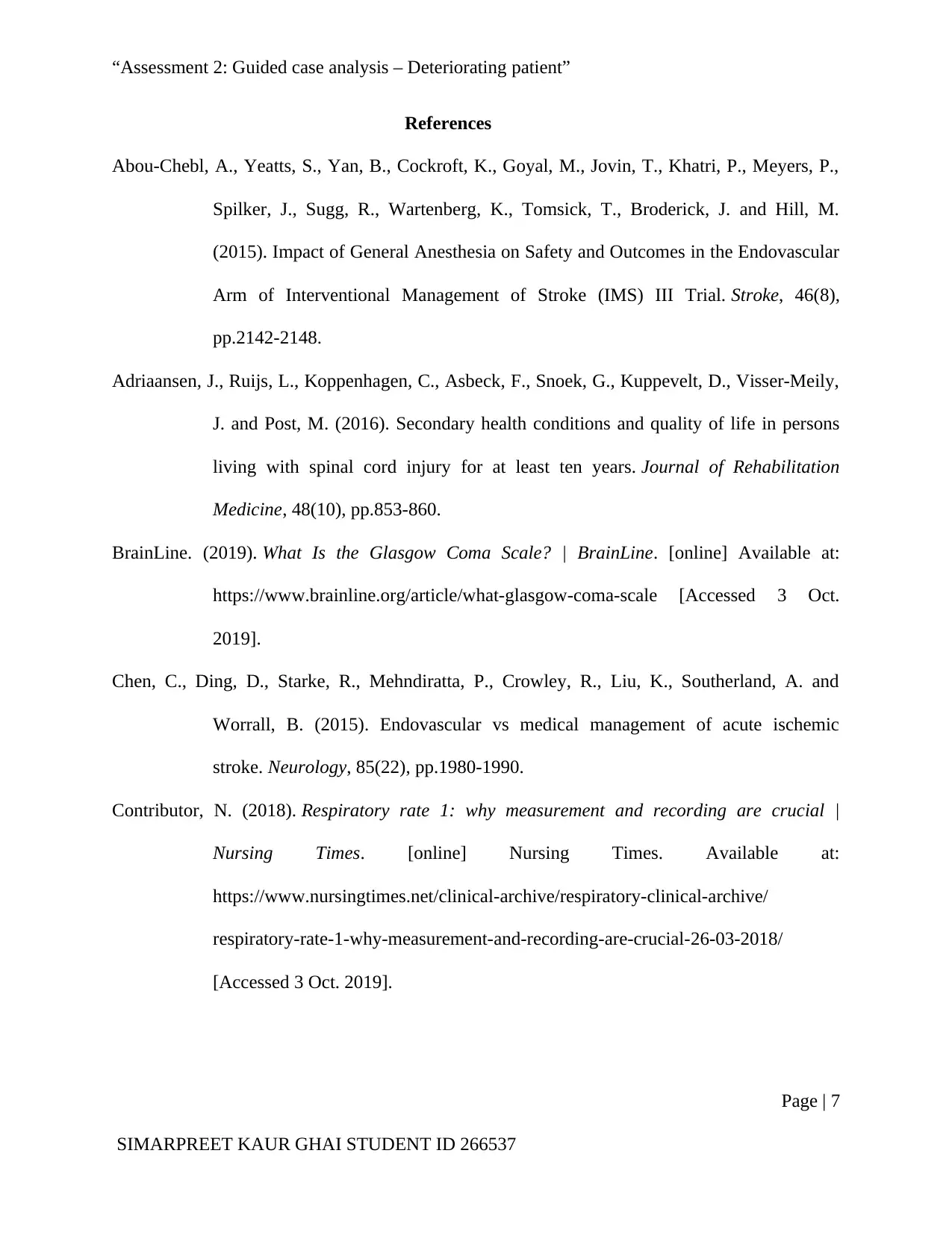
“Assessment 2: Guided case analysis – Deteriorating patient”
References
Abou-Chebl, A., Yeatts, S., Yan, B., Cockroft, K., Goyal, M., Jovin, T., Khatri, P., Meyers, P.,
Spilker, J., Sugg, R., Wartenberg, K., Tomsick, T., Broderick, J. and Hill, M.
(2015). Impact of General Anesthesia on Safety and Outcomes in the Endovascular
Arm of Interventional Management of Stroke (IMS) III Trial. Stroke, 46(8),
pp.2142-2148.
Adriaansen, J., Ruijs, L., Koppenhagen, C., Asbeck, F., Snoek, G., Kuppevelt, D., Visser-Meily,
J. and Post, M. (2016). Secondary health conditions and quality of life in persons
living with spinal cord injury for at least ten years. Journal of Rehabilitation
Medicine, 48(10), pp.853-860.
BrainLine. (2019). What Is the Glasgow Coma Scale? | BrainLine. [online] Available at:
https://www.brainline.org/article/what-glasgow-coma-scale [Accessed 3 Oct.
2019].
Chen, C., Ding, D., Starke, R., Mehndiratta, P., Crowley, R., Liu, K., Southerland, A. and
Worrall, B. (2015). Endovascular vs medical management of acute ischemic
stroke. Neurology, 85(22), pp.1980-1990.
Contributor, N. (2018). Respiratory rate 1: why measurement and recording are crucial |
Nursing Times. [online] Nursing Times. Available at:
https://www.nursingtimes.net/clinical-archive/respiratory-clinical-archive/
respiratory-rate-1-why-measurement-and-recording-are-crucial-26-03-2018/
[Accessed 3 Oct. 2019].
Page | 7
SIMARPREET KAUR GHAI STUDENT ID 266537
References
Abou-Chebl, A., Yeatts, S., Yan, B., Cockroft, K., Goyal, M., Jovin, T., Khatri, P., Meyers, P.,
Spilker, J., Sugg, R., Wartenberg, K., Tomsick, T., Broderick, J. and Hill, M.
(2015). Impact of General Anesthesia on Safety and Outcomes in the Endovascular
Arm of Interventional Management of Stroke (IMS) III Trial. Stroke, 46(8),
pp.2142-2148.
Adriaansen, J., Ruijs, L., Koppenhagen, C., Asbeck, F., Snoek, G., Kuppevelt, D., Visser-Meily,
J. and Post, M. (2016). Secondary health conditions and quality of life in persons
living with spinal cord injury for at least ten years. Journal of Rehabilitation
Medicine, 48(10), pp.853-860.
BrainLine. (2019). What Is the Glasgow Coma Scale? | BrainLine. [online] Available at:
https://www.brainline.org/article/what-glasgow-coma-scale [Accessed 3 Oct.
2019].
Chen, C., Ding, D., Starke, R., Mehndiratta, P., Crowley, R., Liu, K., Southerland, A. and
Worrall, B. (2015). Endovascular vs medical management of acute ischemic
stroke. Neurology, 85(22), pp.1980-1990.
Contributor, N. (2018). Respiratory rate 1: why measurement and recording are crucial |
Nursing Times. [online] Nursing Times. Available at:
https://www.nursingtimes.net/clinical-archive/respiratory-clinical-archive/
respiratory-rate-1-why-measurement-and-recording-are-crucial-26-03-2018/
[Accessed 3 Oct. 2019].
Page | 7
SIMARPREET KAUR GHAI STUDENT ID 266537
Paraphrase This Document
Need a fresh take? Get an instant paraphrase of this document with our AI Paraphraser
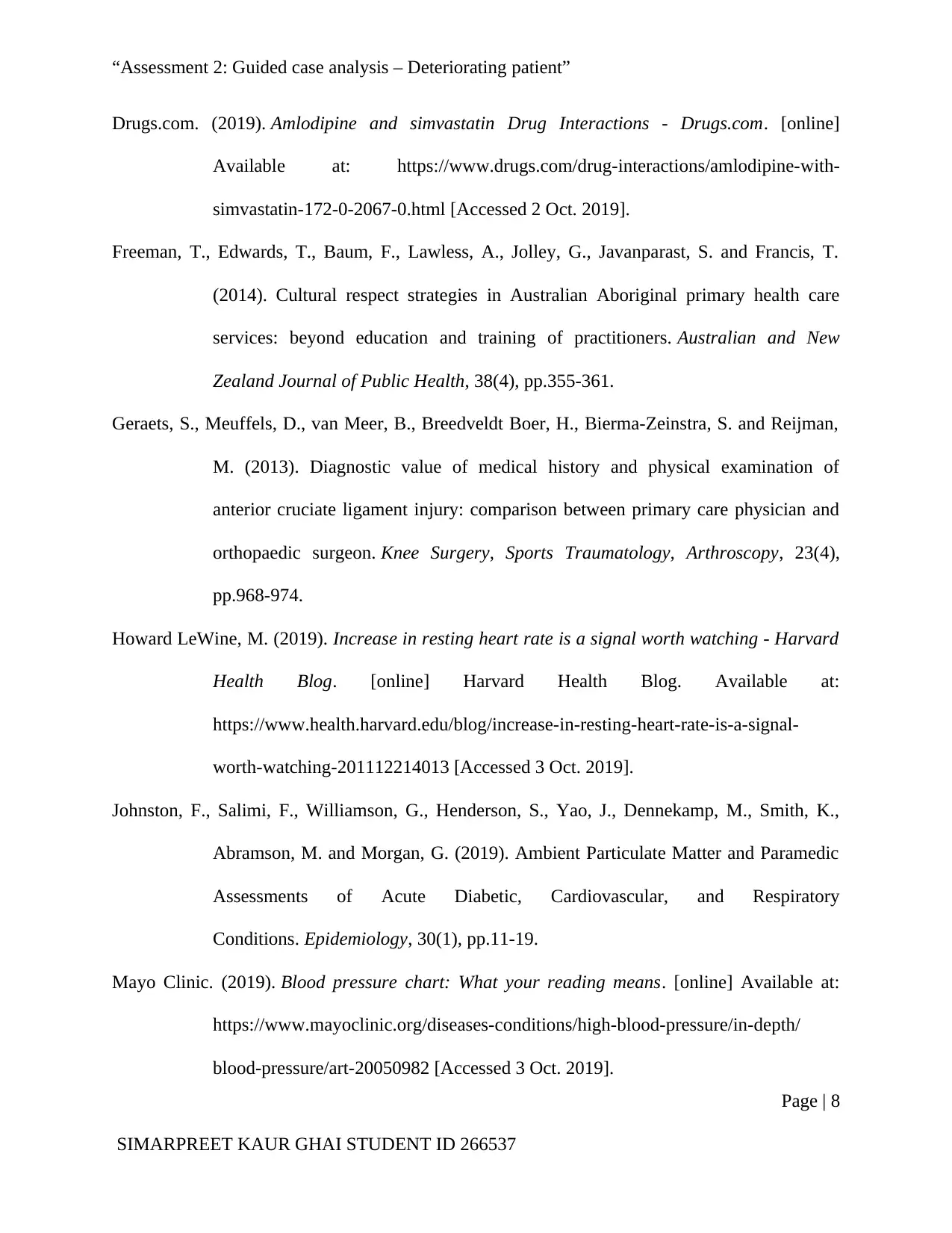
“Assessment 2: Guided case analysis – Deteriorating patient”
Drugs.com. (2019). Amlodipine and simvastatin Drug Interactions - Drugs.com. [online]
Available at: https://www.drugs.com/drug-interactions/amlodipine-with-
simvastatin-172-0-2067-0.html [Accessed 2 Oct. 2019].
Freeman, T., Edwards, T., Baum, F., Lawless, A., Jolley, G., Javanparast, S. and Francis, T.
(2014). Cultural respect strategies in Australian Aboriginal primary health care
services: beyond education and training of practitioners. Australian and New
Zealand Journal of Public Health, 38(4), pp.355-361.
Geraets, S., Meuffels, D., van Meer, B., Breedveldt Boer, H., Bierma-Zeinstra, S. and Reijman,
M. (2013). Diagnostic value of medical history and physical examination of
anterior cruciate ligament injury: comparison between primary care physician and
orthopaedic surgeon. Knee Surgery, Sports Traumatology, Arthroscopy, 23(4),
pp.968-974.
Howard LeWine, M. (2019). Increase in resting heart rate is a signal worth watching - Harvard
Health Blog. [online] Harvard Health Blog. Available at:
https://www.health.harvard.edu/blog/increase-in-resting-heart-rate-is-a-signal-
worth-watching-201112214013 [Accessed 3 Oct. 2019].
Johnston, F., Salimi, F., Williamson, G., Henderson, S., Yao, J., Dennekamp, M., Smith, K.,
Abramson, M. and Morgan, G. (2019). Ambient Particulate Matter and Paramedic
Assessments of Acute Diabetic, Cardiovascular, and Respiratory
Conditions. Epidemiology, 30(1), pp.11-19.
Mayo Clinic. (2019). Blood pressure chart: What your reading means. [online] Available at:
https://www.mayoclinic.org/diseases-conditions/high-blood-pressure/in-depth/
blood-pressure/art-20050982 [Accessed 3 Oct. 2019].
Page | 8
SIMARPREET KAUR GHAI STUDENT ID 266537
Drugs.com. (2019). Amlodipine and simvastatin Drug Interactions - Drugs.com. [online]
Available at: https://www.drugs.com/drug-interactions/amlodipine-with-
simvastatin-172-0-2067-0.html [Accessed 2 Oct. 2019].
Freeman, T., Edwards, T., Baum, F., Lawless, A., Jolley, G., Javanparast, S. and Francis, T.
(2014). Cultural respect strategies in Australian Aboriginal primary health care
services: beyond education and training of practitioners. Australian and New
Zealand Journal of Public Health, 38(4), pp.355-361.
Geraets, S., Meuffels, D., van Meer, B., Breedveldt Boer, H., Bierma-Zeinstra, S. and Reijman,
M. (2013). Diagnostic value of medical history and physical examination of
anterior cruciate ligament injury: comparison between primary care physician and
orthopaedic surgeon. Knee Surgery, Sports Traumatology, Arthroscopy, 23(4),
pp.968-974.
Howard LeWine, M. (2019). Increase in resting heart rate is a signal worth watching - Harvard
Health Blog. [online] Harvard Health Blog. Available at:
https://www.health.harvard.edu/blog/increase-in-resting-heart-rate-is-a-signal-
worth-watching-201112214013 [Accessed 3 Oct. 2019].
Johnston, F., Salimi, F., Williamson, G., Henderson, S., Yao, J., Dennekamp, M., Smith, K.,
Abramson, M. and Morgan, G. (2019). Ambient Particulate Matter and Paramedic
Assessments of Acute Diabetic, Cardiovascular, and Respiratory
Conditions. Epidemiology, 30(1), pp.11-19.
Mayo Clinic. (2019). Blood pressure chart: What your reading means. [online] Available at:
https://www.mayoclinic.org/diseases-conditions/high-blood-pressure/in-depth/
blood-pressure/art-20050982 [Accessed 3 Oct. 2019].
Page | 8
SIMARPREET KAUR GHAI STUDENT ID 266537
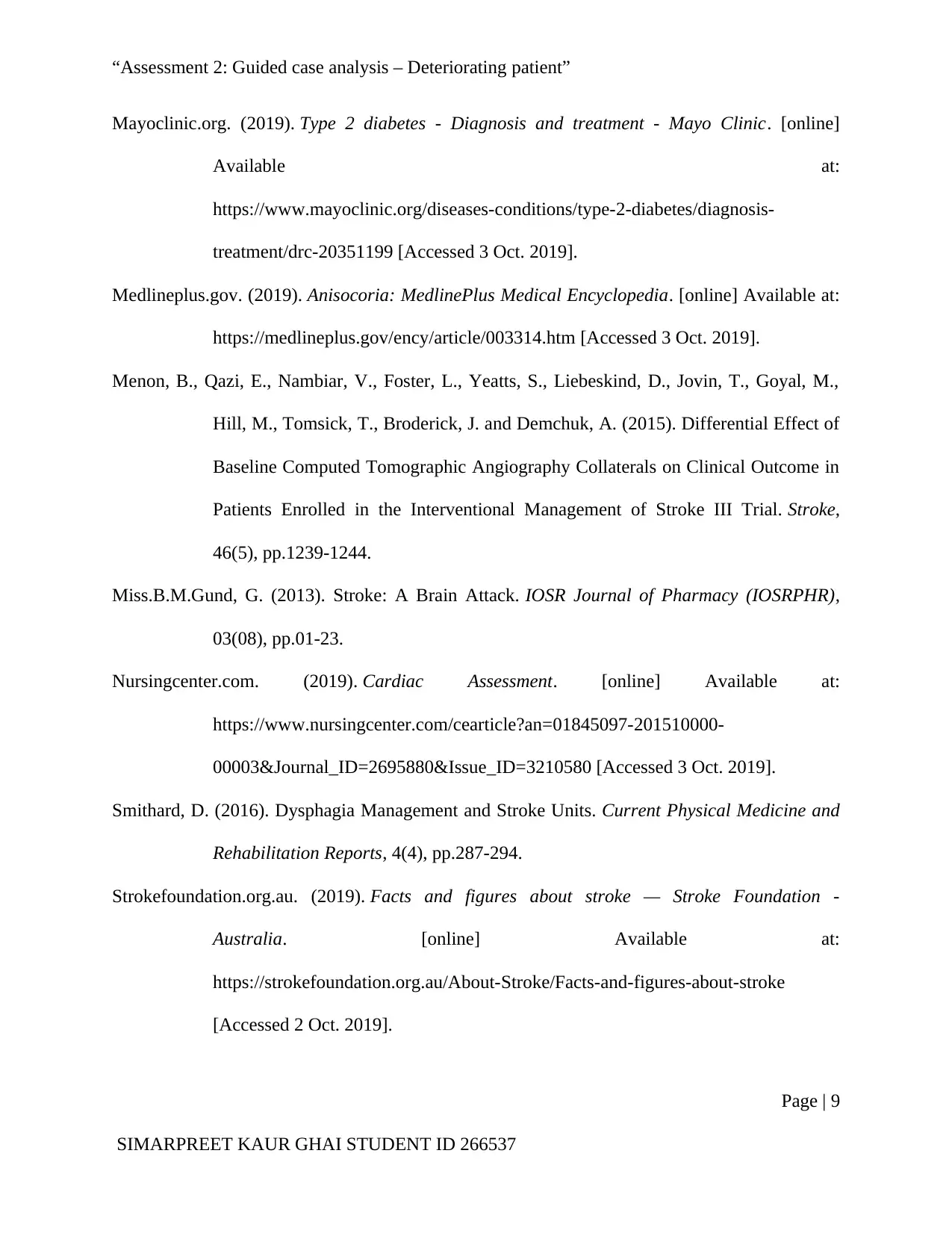
“Assessment 2: Guided case analysis – Deteriorating patient”
Mayoclinic.org. (2019). Type 2 diabetes - Diagnosis and treatment - Mayo Clinic. [online]
Available at:
https://www.mayoclinic.org/diseases-conditions/type-2-diabetes/diagnosis-
treatment/drc-20351199 [Accessed 3 Oct. 2019].
Medlineplus.gov. (2019). Anisocoria: MedlinePlus Medical Encyclopedia. [online] Available at:
https://medlineplus.gov/ency/article/003314.htm [Accessed 3 Oct. 2019].
Menon, B., Qazi, E., Nambiar, V., Foster, L., Yeatts, S., Liebeskind, D., Jovin, T., Goyal, M.,
Hill, M., Tomsick, T., Broderick, J. and Demchuk, A. (2015). Differential Effect of
Baseline Computed Tomographic Angiography Collaterals on Clinical Outcome in
Patients Enrolled in the Interventional Management of Stroke III Trial. Stroke,
46(5), pp.1239-1244.
Miss.B.M.Gund, G. (2013). Stroke: A Brain Attack. IOSR Journal of Pharmacy (IOSRPHR),
03(08), pp.01-23.
Nursingcenter.com. (2019). Cardiac Assessment. [online] Available at:
https://www.nursingcenter.com/cearticle?an=01845097-201510000-
00003&Journal_ID=2695880&Issue_ID=3210580 [Accessed 3 Oct. 2019].
Smithard, D. (2016). Dysphagia Management and Stroke Units. Current Physical Medicine and
Rehabilitation Reports, 4(4), pp.287-294.
Strokefoundation.org.au. (2019). Facts and figures about stroke — Stroke Foundation -
Australia. [online] Available at:
https://strokefoundation.org.au/About-Stroke/Facts-and-figures-about-stroke
[Accessed 2 Oct. 2019].
Page | 9
SIMARPREET KAUR GHAI STUDENT ID 266537
Mayoclinic.org. (2019). Type 2 diabetes - Diagnosis and treatment - Mayo Clinic. [online]
Available at:
https://www.mayoclinic.org/diseases-conditions/type-2-diabetes/diagnosis-
treatment/drc-20351199 [Accessed 3 Oct. 2019].
Medlineplus.gov. (2019). Anisocoria: MedlinePlus Medical Encyclopedia. [online] Available at:
https://medlineplus.gov/ency/article/003314.htm [Accessed 3 Oct. 2019].
Menon, B., Qazi, E., Nambiar, V., Foster, L., Yeatts, S., Liebeskind, D., Jovin, T., Goyal, M.,
Hill, M., Tomsick, T., Broderick, J. and Demchuk, A. (2015). Differential Effect of
Baseline Computed Tomographic Angiography Collaterals on Clinical Outcome in
Patients Enrolled in the Interventional Management of Stroke III Trial. Stroke,
46(5), pp.1239-1244.
Miss.B.M.Gund, G. (2013). Stroke: A Brain Attack. IOSR Journal of Pharmacy (IOSRPHR),
03(08), pp.01-23.
Nursingcenter.com. (2019). Cardiac Assessment. [online] Available at:
https://www.nursingcenter.com/cearticle?an=01845097-201510000-
00003&Journal_ID=2695880&Issue_ID=3210580 [Accessed 3 Oct. 2019].
Smithard, D. (2016). Dysphagia Management and Stroke Units. Current Physical Medicine and
Rehabilitation Reports, 4(4), pp.287-294.
Strokefoundation.org.au. (2019). Facts and figures about stroke — Stroke Foundation -
Australia. [online] Available at:
https://strokefoundation.org.au/About-Stroke/Facts-and-figures-about-stroke
[Accessed 2 Oct. 2019].
Page | 9
SIMARPREET KAUR GHAI STUDENT ID 266537
⊘ This is a preview!⊘
Do you want full access?
Subscribe today to unlock all pages.

Trusted by 1+ million students worldwide
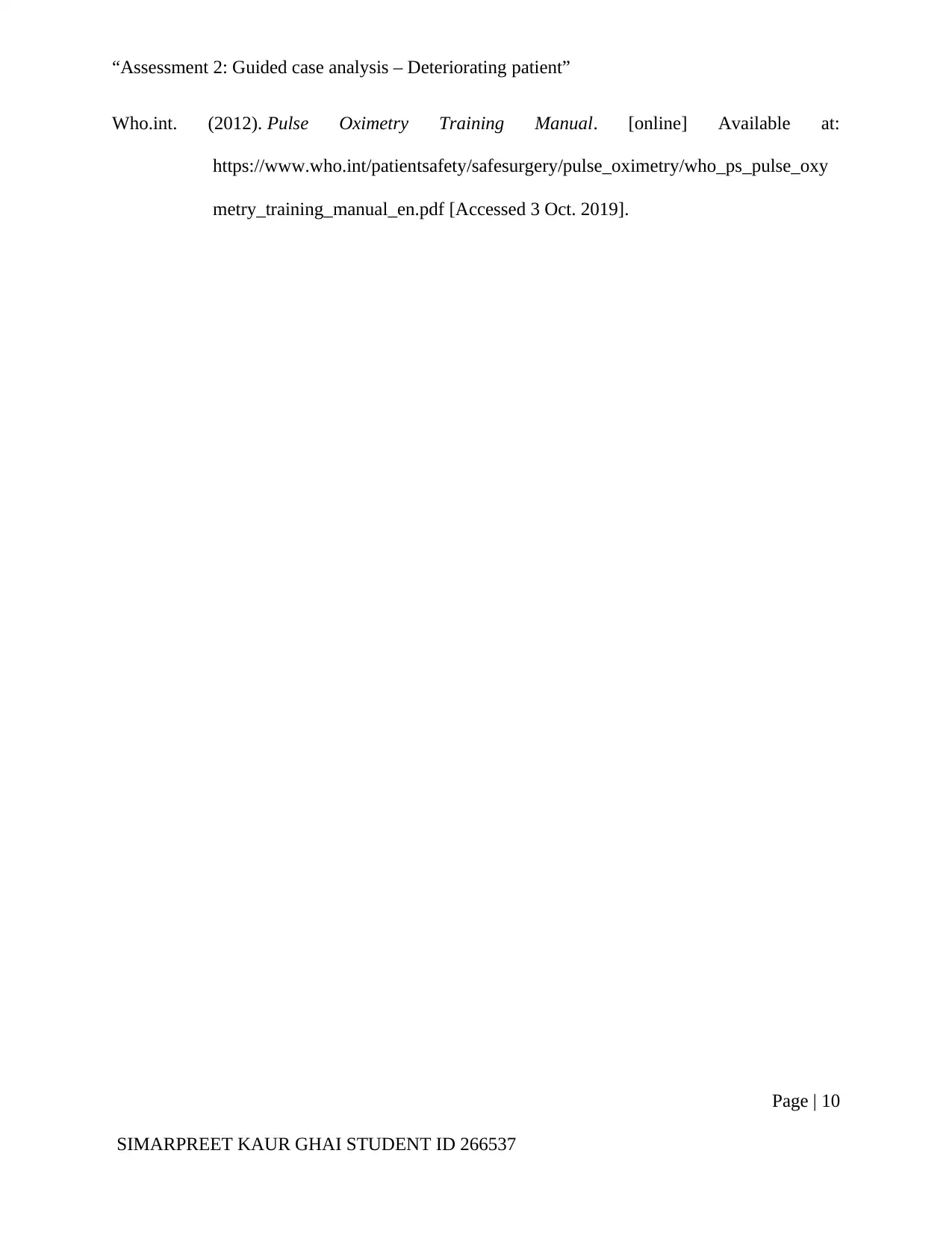
“Assessment 2: Guided case analysis – Deteriorating patient”
Who.int. (2012). Pulse Oximetry Training Manual. [online] Available at:
https://www.who.int/patientsafety/safesurgery/pulse_oximetry/who_ps_pulse_oxy
metry_training_manual_en.pdf [Accessed 3 Oct. 2019].
Page | 10
SIMARPREET KAUR GHAI STUDENT ID 266537
Who.int. (2012). Pulse Oximetry Training Manual. [online] Available at:
https://www.who.int/patientsafety/safesurgery/pulse_oximetry/who_ps_pulse_oxy
metry_training_manual_en.pdf [Accessed 3 Oct. 2019].
Page | 10
SIMARPREET KAUR GHAI STUDENT ID 266537
1 out of 10
Related Documents
Your All-in-One AI-Powered Toolkit for Academic Success.
+13062052269
info@desklib.com
Available 24*7 on WhatsApp / Email
![[object Object]](/_next/static/media/star-bottom.7253800d.svg)
Unlock your academic potential
Copyright © 2020–2025 A2Z Services. All Rights Reserved. Developed and managed by ZUCOL.





